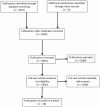The power of the web: a systematic review of studies of the influence of the internet on self-harm and suicide in young people
- PMID: 24204868
- PMCID: PMC3813687
- DOI: 10.1371/journal.pone.0077555
The power of the web: a systematic review of studies of the influence of the internet on self-harm and suicide in young people
Abstract
Background: There is concern that the internet is playing an increasing role in self-harm and suicide. In this study we systematically review and analyse research literature to determine whether there is evidence that the internet influences the risk of self-harm or suicide in young people.
Methods: An electronic literature search was conducted using the PsycINFO, MEDLINE, EMBASE, Scopus, and CINAHL databases. Articles of interest were those that included empirical data on the internet, self-harm or suicide, and young people. The articles were initially screened based on titles and abstracts, then by review of the full publications, after which those included in the review were subjected to data extraction, thematic analysis and quality rating.
Results: Youth who self-harm or are suicidal often make use of the internet. It is most commonly used for constructive reasons such as seeking support and coping strategies, but may exert a negative influence, normalising self-harm and potentially discouraging disclosure or professional help-seeking. The internet has created channels of communication that can be misused to 'cyber-bully' peers; both cyber-bullying and general internet use have been found to correlate with increased risk of self-harm, suicidal ideation, and depression. Correlations have also been found between internet exposure and violent methods of self-harm.
Conclusions: Internet use may exert both positive and negative effects on young people at risk of self-harm or suicide. Careful high quality research is needed to better understand how internet media may exert negative influences and should also focus on how the internet might be utilised to intervene with vulnerable young people.
Conflict of interest statement
Figures
References
-
- Becker K, Mayer M, Nagenborg M, El-Faddagh M, Schmidt MH (2004) Parasuicide online: Can suicide websites trigger suicidal behaviour in predisposed adolescents? Nord J Psychiatry 58: 111–114. - PubMed
-
- Bollen KA, Phillips DP (1982) Imitative suicides: a national study of the effects of television news stories. Am Sociol Rev 47: 802–809. - PubMed
-
- Phillips DP, Leysna M, Paight DJ (1992) Suicide and the media. In: Maris RW, Berman A, Maltsberger JT, Yufit RI, editors. Assessment and prediction of suicide. New York: The Guilford Press. 499–519.
-
- Schmidtke A, Hafner H (1989) Public attitudes towards and effects of the mass media on suicidal and deliberate self-harm behavior. In: Diekstra RFW, Maris R, Platt S, Schmidtke A, Sonneck G, editors. Suicide and its Prevention. Leiden/New York/Copenhagen/Cologne: E.J. Brill. 313–330.
Publication types
MeSH terms
LinkOut - more resources
Full Text Sources
Other Literature Sources
Medical


